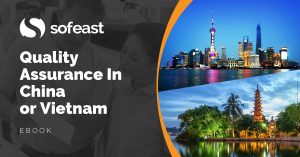A few months ago, I wrote an explanation about the “AQL“: what it is and how to use it. I also listed a few frequent questions, but it seems like I forgot one of them:
What AQL tolerance is suitable to my products?
Unfortunately, it is hard to base this on statistical reasoning. So I don’t have any definitive answer.
The right AQL depends on three things:
- The market you are selling into,
- The kind of risk the users run by using/consuming/getting close to your product,
- The amount of efforts spent at the new product development phase.
1. What your market/customers can accept
The most common AQL chosen by importers is 2.5% for major defects, 4.0 for minor defects, and 0.1 for critical defects. It is considered the “standard” tolerance for most consumer products sold in supermarkets in North America and in Europe.
Based on this standard, you can adjust an AQL that is a bit stricter (say, 1.0/2.5/0.10) if you sell your products in a high-end boutique channel. Or a bit looser (say, 4.0/6.5/0.1) for sale on a particularly low-end market.
Watch this video and learn how to improve management of quality from Chinese & Asian suppliers
2. The user risk
For many car and plane parts, and for pharmaceuticals, the accepted defect rate is much lower than 1%.
That’s even more true when a bad part might cause injury or death. There is no way to set an AQL in that case — it always has to be a zero tolerance.
They also want to reduce the proportion of products with non-safety-related failures. AQL limits of 1.0 or higher are not realistic here. Those failures have to be very low, since they’ve are so costly (e.g. having to call a car back for repair).
To do this, they have to spend efforts on:
- Risk analyses and accelerated reliability testing on the design (at the drawing and prototyping stages);
- Good process engineering and good testing stations;
- Great process controls during manufacturing;
- Intuitive interfaces for users, warnings when necessary, etc.
3. Efforts spent at the new product development phase
Let’s take the example of the consumer electronics industry. When a company spends, say, a million USD developing a new product that aims at sales of 500,000 units a year, they negotiate lower limits.
It depends on the amount of efforts they have spent (see section 2 above) and on product complexity. They can usually aim for these limits:
- Low to average efforts: 1.0% for major defects
- Average to high efforts: 0.6% for major defects
- Very high efforts: 0.25% for major defects
(Source)
To sum up:
There are no guidelines for deciding what AQL limits to choose. You have to decide what your tolerance will be. If the whole batch should not contain more than 1.0% of a certain kind of defect (over the long run), then the AQL should be 1.0% for this kind of defect.
Also, keep in mind, the AQL limit is all about the manufacturing quality, just after production is over. You also need to factor in your product’s reliability & durability.
Is it clear? Let me know if you have any questions by leaving a comment, please.
Additional resource >> Learn even more about QC, read our detailed Quality Control basic concepts post here.
Get expert help to improve YOUR product quality from suppliers in China or Vietnam. Read: Quality Assurance In China Or Vietnam For Beginners
Grab your free copy of Sofeast’s eBook and learn the common traps new importers from China or Vietnam fall into, and how to avoid or overcome them in order to get the best possible production results. It also outlines a proven quality assurance strategy that you can follow in order to have better control over your product quality, covering:
- Finding Suitable Suppliers
- Defining your Requirements before Production Starts
- Don’t Skip the New Product Introduction Process
- Regular Quality Inspections (Trust but Verify)
- Tying Payments to Quality Approvals
Sounds good? Hit the button below to get your copy now:




great guy thanks
Apparently the AQL is readily applicable to products that can be counted as “pieces” and “units”…How can it be applicable to products which are in (liquid) bulk and which are measured in terms of “metric tons”? Pls. help.
Forget about this AQL in this case. Single stage sampling plans by attributes probably don’t make sense. You should probably go for a “accept on zero” plan: either what you test is good, or it’s all rejected.
Renaud,thank you , i have find this for days ,But would you like to give me some suggestion where i can find out the most common AQL for pharmaceuticals.the websites ,forums ,bbs and so on,thanks!
I guess the pharma industry, like the car industry, has such a high quality standard that it doesn’t use the AQL.
With my company’s manufacturing for Boeing, for instance, we utilize a C=0 sampling method. I suspect pharmaceuticals use a similar method.
Yes that wouldn’t be surprising.
Hi Renaud, thank you for your website..
My question is about pharma market, but i’ve to validate only a data migration of critical records..
should i use AQL? which value?
I don’t know anything about the parma industry, sorry.
and about data migration in any industry?
tks
Please give more information about what you need to do. Why are you trying to use the statistics related to AQL, when it comes to migrating data?
Someone tell me to follow the procedure in ISO_2859-4;2002(E) wich contains AQL.
I’ve to validate a migration from Oracle to SAP with attribute
Oh I see. Iso 2859-4 is totally different from ISO 2859-1 (the standard I describe on this website). i have never worked on ISO 2859-4, so I can’t help. It seems to follow an approach totally different from that of -1.
For more info, all I can point you to is http://www.iso.org/iso/home/store/catalogue_tc/catalogue_detail.htm?csnumber=36164.
Thank you very much Renaud
Hi, Anjoran,
With AQL 2.5, How to change it to percent? Is it the same
Do NOT convert it to percentages. See below for explanation.
Q: Based on my AQL, I calculated the proportion of defects authorized. Why don’t they correspond to the maximum number of defects authorized?
A: It is true. In our example above, 2.5% of 200 samples is 5 samples, but we accept the goods even if 10 samples are found with a major defect.
Why this difference? There are heavy statistics behind this issue. To keep it simple, the producer’s risk is his risk of rejection (based on the random element when drawing the sample) even though his products (if they were all checked) would be accepted. That risk is about 5% in this standard. And, in the same logic, there is a consumer’s risk and is is around 10%. As you can see, this standard is favorable to the producer’s side.
If you have access to Youtube, you should also watch this video: http://www.youtube.com/watch?v=8bUe8nQpI0s
hi Mr Anjoran.
From http://www.ask.com/question/what-is-aql-2-5 has explaint about AQL 2.5 like this:
AQL stands for Acceptable Quantity Limit and can be defined as the quality level that is tolerable for consumer goods. AQL 2.5 is a type of limit for most consumer goods which means that 2.5% of the defective goods or products would usually not be considered acceptable by the end user.
Is it mean: AQL 2.5 the same 2.5%?
No it’s not. And it is now called “acceptance quality limit” in the standards. Not “acceptable” and not “quantity”.
Besides the wrong name, the definition you got from that website is erroneous on several levels.
Dear Mr Anjoran,
Thank you for your explain.
By the way, what’s different between general inspection level? and when do we use special inspection level S1,S2…..? Pls help me…
I invite you to read http://www.qualityinspection.org/inspection-level/.
Hi Anjoran!
My company has an AQL for critical defect equal to 0.04%, major defect of 0.4% and minor defect of 1.5%. I just want to ask if you know what is the basis of this AQL and how they arrive with these. My company is bottling company producing alcoholic beverages
Hi, as I wrote in this article, it is hard to base this on statistical reasoning and there is usually not definitive answer. I guess you should ask them…
Which AQL should I adopt when checking the standard of cleanliness of toilet in a public toilet of a train station during its inspection?
How can we select which AQL is suitable and how frequent of cleaning is needed per hour basis?.
Do not use the AQL for that. There are many, many other sampling plans, and some of them certainly make more sense.
See https://qualityinspection.org/sampling-plans for a few examples.
Can you recommend which sampling plan to choose?
Unfortunately, I have no idea…
Which AQL levels do you recommend for handcrafted products?
It depends on what your target market can accept. Usually, 0C, 2.5M, and 4.0m is good.